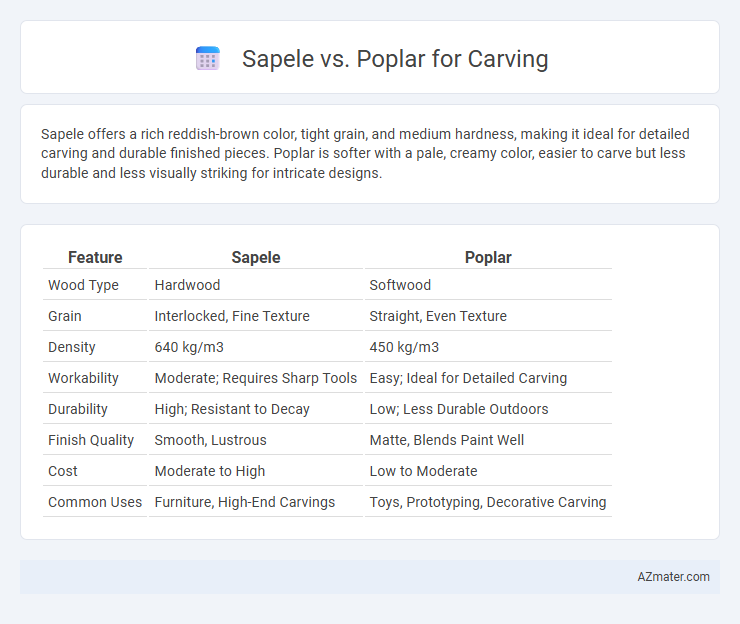Sapele offers a rich reddish-brown color, tight grain, and medium hardness, making it ideal for detailed carving and durable finished pieces. Poplar is softer with a pale, creamy color, easier to carve but less durable and less visually striking for intricate designs.
Table of Comparison
| Feature | Sapele | Poplar |
|---|---|---|
| Wood Type | Hardwood | Softwood |
| Grain | Interlocked, Fine Texture | Straight, Even Texture |
| Density | 640 kg/m3 | 450 kg/m3 |
| Workability | Moderate; Requires Sharp Tools | Easy; Ideal for Detailed Carving |
| Durability | High; Resistant to Decay | Low; Less Durable Outdoors |
| Finish Quality | Smooth, Lustrous | Matte, Blends Paint Well |
| Cost | Moderate to High | Low to Moderate |
| Common Uses | Furniture, High-End Carvings | Toys, Prototyping, Decorative Carving |
Introduction: Sapele vs Poplar for Carving
Sapele wood features a rich reddish-brown hue with a fine, interlocking grain that offers durability and a smooth carving experience, making it popular for detailed woodwork and instruments. Poplar is a softer, pale-colored hardwood with a straight grain, prized for its ease of carving and affordability, though it may not hold intricate details as sharply as harder woods. Both woods provide unique benefits for carving projects, with Sapele favored for strength and finish quality, while Poplar suits beginners and budget-conscious carvers.
Wood Grain and Texture: Sapele vs Poplar
Sapele features a fine, interlocking grain that produces a smooth, lustrous texture ideal for detailed carving, while Poplar has a straight, uniform grain with a softer texture that can be prone to dents and less defined carving edges. The dense, hardwood nature of Sapele offers greater durability and a richer finish compared to Poplar's lighter, more porous structure. For sculptors requiring sharp details and a polished finish, Sapele is preferable, whereas Poplar suits projects where ease of carving and affordability are priorities.
Workability and Ease of Carving
Sapele offers a medium density with a fine, interlocking grain that provides moderate workability but can be challenging for delicate carving due to occasional grain tear-out. Poplar, being a softer and more uniform wood with a straight grain, excels in ease of carving, making it ideal for beginners and intricate details. Carvers often prefer Poplar for projects requiring precision and smooth cuts, while Sapele is selected for its durability and richer color despite a slightly tougher carving experience.
Durability and Strength Comparison
Sapele offers superior durability and strength compared to poplar, making it ideal for intricate carving projects requiring long-lasting results. Its dense, hardwood structure provides excellent resistance to wear and impact, while poplar, a softer wood, tends to be less resistant to dents and scratches. Choosing Sapele enhances the longevity and robustness of carved pieces, particularly for functional or decorative items exposed to frequent handling.
Color and Aesthetic Differences
Sapele wood features a rich, reddish-brown hue with interlocking grain patterns that create a lustrous, ribbon-like effect, making it ideal for carvings requiring a warm, luxurious appearance. Poplar exhibits a pale cream to light green or brown coloration with a relatively straight grain, offering a more subdued and uniform aesthetic suitable for projects emphasizing subtlety and smooth finishes. The distinct color vibrancy and grain complexity of Sapele provide a striking contrast to Poplar's softer, more neutral palette.
Cost and Availability of Both Woods
Sapele offers a richer, reddish-brown hue with medium hardness, making it a popular choice for carving projects that require durability, though it generally costs more due to its tropical origin and limited availability outside Africa. Poplar, widely available in North America, is a softer wood with a pale color, offering a more budget-friendly option for carvers, especially beginners, because it is easier to work with and commonly stocked in lumberyards. When choosing between the two, carvers seeking affordability and ease often prefer poplar, whereas those prioritizing aesthetic appeal and durability might invest in the higher-priced sapele.
Tools and Techniques for Each Wood
Sapele, known for its density and interlocked grain, requires sharp, high-quality carbide or micro-grain chisels and gouges to prevent tearing during carving, with techniques emphasizing controlled, shallow cuts to navigate its fibrous texture. Poplar offers a softer, more uniform grain, allowing the use of standard carbon or high-speed steel tools and enabling more aggressive carving strokes and fine detail work without excessive tool wear. Mastery of these woods involves adjusting tool angles and cutting speeds: slower, precise carving for sapele to avoid splintering, and faster, freer cuts for poplar to exploit its softness and ease of shaping.
Best Uses: Sapele vs Poplar in Carving Projects
Sapele offers a rich, reddish-brown hue and fine grain, making it ideal for detailed, high-end carving projects such as decorative furniture and musical instruments. Poplar, with its softer texture and pale, uniform color, excels in beginner carvings, prototypes, and painted crafts where intricate grain patterns are less critical. Choosing between Sapele and Poplar depends on project requirements for durability, finish quality, and aesthetic appeal in carving applications.
Finishing Qualities and Staining Potential
Sapele offers a rich, reddish-brown hue with a natural luster that enhances detailed carving projects and finishes smoothly to a satin sheen. Poplar, being a softer wood with a pale yellow to greenish tone, absorbs stains unevenly, often requiring a pre-conditioner for consistent coloring. Sapele's dense grain patterns provide better staining potential, making it ideal for fine, polished finishes in woodworking and carving applications.
Conclusion: Choosing the Right Wood for Carving
Sapele offers a dense, fine grain structure that provides durability and a rich reddish-brown hue, making it ideal for detailed, long-lasting carvings. Poplar is softer and more affordable, with a lighter color that is easier to carve but less resistant to wear over time. Selecting between Sapele and Poplar depends on the desired finish and durability, with Sapele favored for high-quality, intricate projects and Poplar suited for beginners and practice pieces.

Infographic: Sapele vs Poplar for Carving
 azmater.com
azmater.com